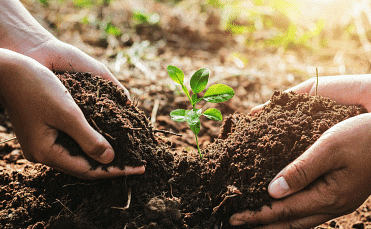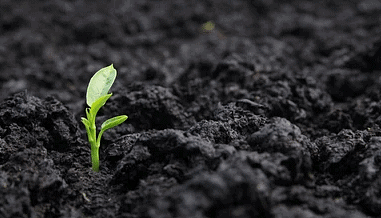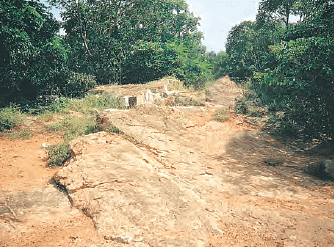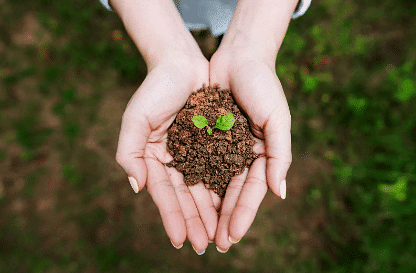Soil Class 7 Notes Science
| Table of contents |

|
| What is Soil? |

|
| Soil Profile |

|
| Classification of Soil |

|
| Properties of Soil |

|
| Soil Erosion |

|
| Soil Conservative |

|
What is Soil?
- Soil is the most important renewable natural resource. It is the medium of plant growth and supports different types of living organisms on the earth.
- The soil is a living system. It takes millions of years to form soil up to a few cm in depth. Relief, parent rock or bedrock, climate, vegetation and other forms of life and time are important factors in the formation of soil.
- Humus refers to the dark, organic matter present in the soil that is formed by the decomposition of plant and animal residues. It is a vital component of soil that helps in retaining moisture, providing nutrients to plants, and maintaining soil structure.
Formation of soil
- Various forces of nature, such as changes in temperature, actions of running water, wind and glaciers, activities of decomposers, etc. contribute to the formation of soil. Chemical and organic changes that take place in the
- Soil is a complex and dynamic system that supports a wide range of plant and animal life.
- The properties of soil, such as texture, structure, and nutrient content, can vary depending on factors such as climate, geology, and land use.
 Soil
Soil
Soil Profile
Different vertical layers of soil are known as Soil Profiles. The feel (texture), color and chemical compositions of soil are different in each layer. Soil Profile
Soil Profile
Horizons
Layers of soil are referred to as Horizons. Horizons of soil are categorized into four types: A-horizon, B-horizon, C-horizon and Bedrock.- A-Horizon: The top layer of soil is called A-horizon. It is also called topsoil. A-horizon is generally dark in color. It is rich in humus. A horizon is generally soft and porous. It retains more water.
The roots of small plants are entirely embedded in topsoil. Topsoil also provides shelter to many living organisms, such as worms, insects, moles, rats, snakes, etc. - B-Horizon: The next layer of the soil from the top is known as B-horizon. This layer is harder and more compact than the topsoil. This is generally known as the middle layer of soil. This is less rich in humus but contains most of the minerals present in the soil.
- C-Horizon: The third layer of soil is known as C-horizon. C-horizon is made of small lumps of rocks with cracks and crevices.
- Bedrock: The layer below the C-horizon is known as bedrock. Bedrock is composed of rocks and is hard to dig with spades.
Classification of Soil
Alluvial soil is a type of soil that is formed by the deposition of sediments brought by rivers, streams, or other water bodies. It is one of the most fertile soils and is found in river valleys, deltas, and floodplains.
 Alluvial SoilBlack Soil is a type of soil found in the Deccan plateau of India that is characterized by its dark color, high clay content, and nutrient-rich composition. Its unique properties make it well-suited for agriculture, particularly for crops such as cotton, soybeans, and wheat.
Alluvial SoilBlack Soil is a type of soil found in the Deccan plateau of India that is characterized by its dark color, high clay content, and nutrient-rich composition. Its unique properties make it well-suited for agriculture, particularly for crops such as cotton, soybeans, and wheat.
 Black SoilRed and Yellow Soil are two types of soil that are found in many parts of the world. They are formed from different types of rocks and have unique characteristics that make them suitable for specific types of crops. Red soil is well-suited for crops that prefer dry conditions, while yellow soil is suitable for crops that require a moderate amount of water.
Black SoilRed and Yellow Soil are two types of soil that are found in many parts of the world. They are formed from different types of rocks and have unique characteristics that make them suitable for specific types of crops. Red soil is well-suited for crops that prefer dry conditions, while yellow soil is suitable for crops that require a moderate amount of water.
 Red SoilLaterite Soil is a type of soil formed from the weathering of rocks in tropical and subtropical regions. It is characterized by its reddish-brown color, high content of iron and aluminum oxides, and low fertility. The soil is typically low in nutrients and has a low water-holding capacity, making it difficult for crops to grow. It can still be used to grow certain crops with proper management.
Red SoilLaterite Soil is a type of soil formed from the weathering of rocks in tropical and subtropical regions. It is characterized by its reddish-brown color, high content of iron and aluminum oxides, and low fertility. The soil is typically low in nutrients and has a low water-holding capacity, making it difficult for crops to grow. It can still be used to grow certain crops with proper management.
 Laterite SoilArid Soil is a type of soil that is found in arid and semi-arid regions, which are characterized by low rainfall and high evaporation rates. It is typically low in organic matter and nutrients and prone to erosion. However, with proper management techniques and crops that are well-adapted to the arid conditions, they can still be used for agriculture.
Laterite SoilArid Soil is a type of soil that is found in arid and semi-arid regions, which are characterized by low rainfall and high evaporation rates. It is typically low in organic matter and nutrients and prone to erosion. However, with proper management techniques and crops that are well-adapted to the arid conditions, they can still be used for agriculture.
 Arid SoilForest Soil is a type of soil that is found in forested areas around the world. It is characterized by its high organic matter content, diverse soil organisms, and unique physical and chemical properties that make it well-suited for supporting a diverse range of plant and animal life. It also plays an important role in carbon storage and is essential for maintaining healthy forest ecosystems.
Arid SoilForest Soil is a type of soil that is found in forested areas around the world. It is characterized by its high organic matter content, diverse soil organisms, and unique physical and chemical properties that make it well-suited for supporting a diverse range of plant and animal life. It also plays an important role in carbon storage and is essential for maintaining healthy forest ecosystems.
 Forest Soil
Forest Soil
Properties of Soil
The properties of soil are its physical, chemical, and biological characteristics that determine its ability to support plant growth and other soil functions.
- The Physical properties of soil include texture, structure, porosity, bulk density, and water-holding capacity.
- The Chemical properties of soil include pH, nutrient content, cation exchange capacity, and organic matter content.
- The Biological properties of soil include the diversity and activity of microorganisms, such as bacteria, fungi, and protozoa, as well as micro-organisms such as earthworms and insects.
Soil Erosion
- Soil erosion is the process by which soil is moved or carried away from its original location by the action of water, wind, or other forces.
- Soil erosion can occur naturally, but it is often accelerated by human activities such as deforestation, overgrazing, and improper land use practices.
- When soil erosion occurs, the top layer of soil is removed, exposing the underlying soil, which may be less fertile and less able to support plant growth.
- This can lead to reduced crop yields, increased soil runoff and sedimentation in nearby bodies of water, and degradation of ecosystems.

Preventive measures for Soil Erosion
- Deforestation should be prevented at all costs to prevent soil erosion.
- Shelterbelt plantation of trees is good for preventing soil erosion.
- Terrace farming in hilly areas is effective in preventing soil erosion.
Soil Conservative
- Soil conservation is the practice of protecting soil from erosion, degradation, and depletion caused by natural or human activities.
- It involves the implementation of various techniques to maintain or improve the fertility, structure, and health of soil for sustainable agriculture and other land uses.
 Soil Conservative
Soil Conservative
- There are various techniques for soil conservation, such as terracing, contour plowing, crop rotation, mulching, and afforestation.
- These methods help to prevent soil erosion, improve soil fertility, and enhance the overall health of the soil.
|
114 videos|387 docs|97 tests
|
FAQs on Soil Class 7 Notes Science
| 1. What is soil? |  |
| 2. What is a soil profile? |  |
| 3. How is soil classified? |  |
| 4. What are the properties of soil? |  |
| 5. What is soil erosion and how is it caused? |  |
| 6. What is soil conservation and why is it important? |  |
















